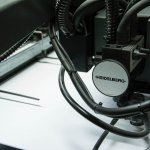How Pneumatic and Hydraulic Systems Work at Amusement Parks
People love amusement parks. They visit them in millions each year. One thing few realize, though, is how often hydraulic and pneumatic systems are used on amusement rides.
What Types of Rides Use Hydraulic and Pneumatic Systems?
Around 80% of amusement devices use hydraulics and pneumatics. If something is physically moving at an amusement park, it’s probably using these systems. Here are some examples.
- Most roller coasters use hydraulic or pneumatic brakes both for safety and for when the cart pulls in to the load/unload station. These brakes keep the passengers safe by automatically activating if one cart comes to a stop. This keeps the carts from bumping into each other, potentially causing injury.
- Lap bars, the large levers that hold passengers in place on roller coasters, are usually powered by pneumatics.
- Airplane/swing rides use hydraulic cylinders to tilt the upper stage and raise the upper platform.
- The shock absorbers on bumper cars are often hydraulic cylinders.
Why Use Hydraulics and Pneumatics over Traditional Pulley Systems?
Hydraulic and pneumatic systems offer several advantages over pulley systems for amusement park rides:
- Control: If the cable breaks on a pulley system, there’s no way to control the machine. Hydraulic and pneumatic equipment offers better, safer control for amusement park rides, although hydraulic and pneumatic systems can also fail.
- Power Density: A hydraulic motor is only ½ to ⅔ the size of a traditional motor yet offers the same horsepower. True, you still need a traditional motor as well to make the hydraulic system work, but it can be far away where it’s more easily accessible and repairable.
- Precision: Hydraulic and pneumatic equipment is more precise than other options. This is especially important for rides like rotors or gravitrons.
- Safety: The increased control and precision makes the rides much safer.
See Our Shop
Are Amusement Parks Safe?
Amusement parks put great emphasis on safety.The rates of accidents are relatively low, but they do occasionally happen. Some news sites advise caution, however, pointing to a lack of regulation by the federal government.
Rides often have one or even two backup systems to prevent accidents. If a system does fail, a device called a counterbalance valve can stop the machine before it spins out of control.
When Should You Use Hydraulics and When Should You Use Pneumatics?
Hydraulics use liquid while pneumatics use air. There are advantages and disadvantages to each, and they are used in different situations for amusement park rides.
Hydraulics are more exact and precise because air is compressible and spongy while liquid is not. Also, hydraulics can be cheaper since compressing air is expensive.
On the other hand, pneumatic systems are simpler and have fewer components.
If you need hydraulic or pneumatic equipment, consider buying from us. We can build all kinds of custom equipment at our facilities. We have locations across Tennessee and have been in business for almost 50 years.










